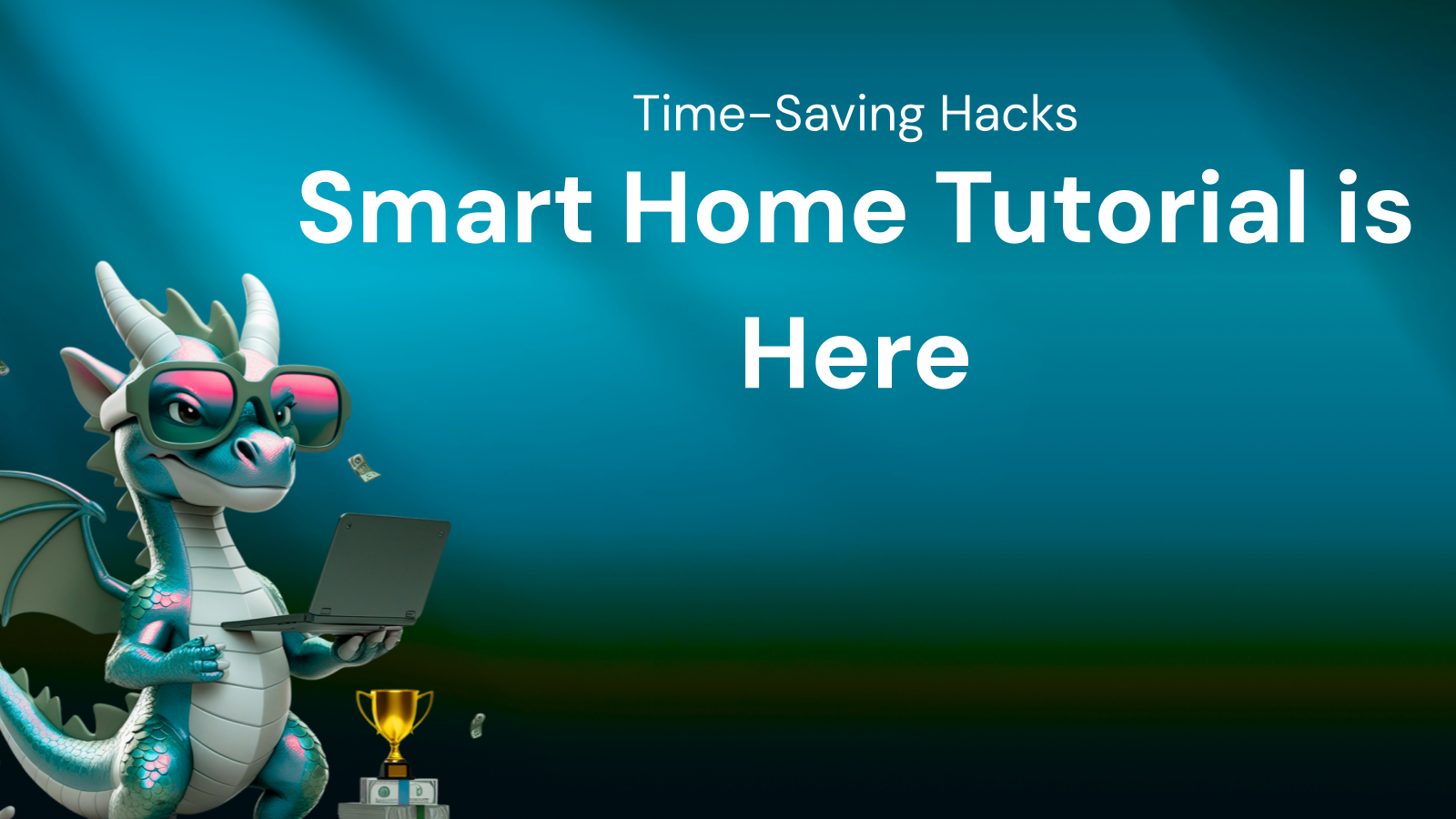How to Master Your Smart Home: An Insider Hacks Tutorial

How to Master Your Smart Home: An Insider Hacks Tutorial
The smart home revolution is well underway, promising a life of convenience, efficiency, and enhanced security. But simply buying a few smart gadgets doesn't automatically grant you smart home mastery. True mastery lies in understanding how to integrate, optimize, and personalize your devices to create a seamless and intuitive living experience.
This comprehensive tutorial dives deep into the insider hacks and strategies needed to truly master your smart home. We'll go beyond the basic setup and explore advanced features, troubleshooting tips, and creative applications to unlock the full potential of your connected ecosystem.
I. Laying the Foundation: Planning and Infrastructure
Before diving into the bells and whistles, a solid foundation is crucial. This involves careful planning and setting up the right infrastructure to support your smart home aspirations.
- Define Your Needs and Priorities: What do you want to achieve with your smart home? Increased security? Enhanced comfort? Energy savings? Start by outlining your goals and prioritizing the features that matter most to you. This will help you avoid unnecessary purchases and focus on building a system that truly benefits you.
- Choose a Smart Home Platform: A smart home platform acts as the central hub, connecting and controlling all your devices. Popular options include:Consider factors like device compatibility, ease of use, privacy features, and integration with your existing devices when choosing a platform. You might even consider a hybrid approach, utilizing multiple platforms for different functionalities.
- Amazon Alexa: User-friendly and widely compatible, Alexa excels at voice control and integrates seamlessly with Amazon services.
- Google Assistant: Known for its AI capabilities and integration with Google's ecosystem, Assistant offers sophisticated voice control and personalized experiences.
- Apple HomeKit: Prioritizes security and privacy, offering seamless integration with Apple devices and a focus on intuitive control.
- Samsung SmartThings: A versatile platform that supports a wide range of devices and protocols, making it a good choice for diverse setups.
- Optimize Your Wi-Fi Network: A strong and reliable Wi-Fi network is the backbone of any smart home. Poor connectivity can lead to frustrating delays, device malfunctions, and a generally subpar experience.
- Upgrade Your Router: If you're using an older router, consider upgrading to a newer model that supports the latest Wi-Fi standards (Wi-Fi 6 or 6E).
- Mesh Wi-Fi System: For larger homes, a mesh Wi-Fi system creates a network of interconnected nodes, providing seamless coverage throughout your property.
- Optimize Router Placement: Position your router in a central, open location, away from obstructions like walls and metal objects.
- Use a Wi-Fi Analyzer: Use a Wi-Fi analyzer app to identify areas with weak signal strength and optimize channel selection for improved performance.
- Create Separate Networks: Consider creating separate Wi-Fi networks for your smart home devices and personal devices for enhanced security and performance.
- Consider Smart Home Hubs: While some devices connect directly to your Wi-Fi, others require a dedicated smart home hub to communicate. Hubs use protocols like Zigbee and Z-Wave, which offer better range and lower power consumption compared to Wi-Fi. Research which protocols your chosen devices use and ensure you have the necessary hub.
II. Device Deep Dive: Unlocking Hidden Features
Once you have a solid foundation, it's time to explore the hidden features and customization options within your smart devices.
- Smart Lighting: Beyond simply turning lights on and off, smart lighting offers a wealth of possibilities.
- Color Temperature Adjustment: Adjust the color temperature of your lights to match your mood and activities. Cool, blue-toned light is ideal for focus and productivity, while warm, amber-toned light promotes relaxation and sleep.
- Dynamic Lighting Scenes: Create custom lighting scenes for different occasions, such as movie night, dinner parties, or waking up gradually in the morning.
- Motion-Activated Lighting: Use motion sensors to automatically turn on lights in hallways, bathrooms, or outdoor areas for added convenience and security.
- Sunrise/Sunset Simulations: Program your lights to gradually brighten in the morning, mimicking a sunrise, or dim in the evening, signaling bedtime.
- Geofencing: Use geofencing to automatically turn on or off lights based on your location, saving energy and providing a sense of security when you're away.
- Smart Thermostats: Smart thermostats not only regulate temperature but also learn your habits and optimize energy consumption.
- Learning Algorithms: Allow your smart thermostat to learn your preferred temperature settings and automatically adjust the temperature based on your schedule.
- Zoned Heating and Cooling: Use smart thermostats in conjunction with smart vents or dampers to create zones with different temperature settings, maximizing comfort and efficiency.
- Energy Reports: Track your energy usage and identify areas where you can save money.
- Remote Control: Adjust the temperature remotely from your smartphone, ensuring your home is comfortable when you arrive.
- Integrate with Weather Forecasts: Program your thermostat to automatically adjust the temperature based on upcoming weather conditions.
- Smart Security Systems: Smart security systems offer comprehensive protection and peace of mind.
- Customizable Alerts: Configure alerts to notify you of specific events, such as door/window openings, motion detection, or unusual sounds.
- Video Surveillance: Install smart cameras with motion detection, night vision, and cloud recording for 24/7 surveillance.
- Facial Recognition: Some smart cameras offer facial recognition, allowing you to identify visitors and receive alerts when unfamiliar faces are detected.
- Two-Way Audio: Communicate with visitors through the camera's built-in microphone and speaker.
- Integration with Emergency Services: Connect your smart security system to emergency services for rapid response in case of an alarm.
- Smart Entertainment: Streamline your entertainment experience with smart speakers, smart TVs, and smart remotes.
- Voice Control: Control your TV, sound system, and streaming services with voice commands.
- Multi-Room Audio: Play music simultaneously in multiple rooms using smart speakers or multi-room audio systems.
- Personalized Playlists: Create personalized playlists and control playback with voice commands.
- Universal Remote Control: Replace multiple remotes with a single smart remote that controls all your entertainment devices.
- Automated Movie Nights: Create a routine that dims the lights, starts the movie, and sets the thermostat to the perfect temperature with a single voice command.
III. Automations and Routines: Creating a Seamless Experience
The true power of a smart home lies in its ability to automate tasks and create personalized routines. This allows you to streamline your daily life and enjoy a truly seamless experience.
- Leverage IFTTT (If This Then That): IFTTT is a powerful web service that allows you to connect different apps and devices to create custom automations. For example:
- "If it starts raining, then close the smart blinds."
- "If my smart doorbell detects motion, then send me a notification and turn on the porch light."
- "If I arrive home, then turn on the lights, unlock the door, and play my favorite music."
- Create Custom Routines with Your Smart Home Platform: Most smart home platforms offer built-in routine creation tools.
- "Good Morning" Routine: Turns on the lights, starts the coffee maker, plays your favorite news podcast, and provides a weather update.
- "Leaving Home" Routine: Turns off the lights, locks the doors, sets the thermostat to away mode, and arms the security system.
- "Movie Night" Routine: Dims the lights, turns on the TV, selects your preferred streaming service, and sets the thermostat to a comfortable temperature.
- "Bedtime" Routine: Turns off the lights, locks the doors, sets the thermostat to sleep mode, and plays white noise to help you fall asleep.
- Use Sensors for Context-Aware Automation: Sensors can provide valuable information about your environment, enabling you to create more sophisticated automations.
- Motion Sensors: Trigger actions based on movement, such as turning on lights in hallways or sending alerts when unexpected motion is detected.
- Temperature Sensors: Adjust the thermostat based on room temperature or send alerts if the temperature drops below a certain threshold.
- Water Leak Sensors: Detect water leaks and send alerts to prevent water damage.
- Contact Sensors: Monitor doors and windows, triggering alarms or sending alerts when they are opened or closed.
IV. Security and Privacy: Protecting Your Connected Home
As your home becomes more connected, it's crucial to prioritize security and privacy.
- Strong Passwords: Use strong, unique passwords for all your smart home devices and accounts. Avoid using default passwords or reusing passwords across multiple services.
- Two-Factor Authentication (2FA): Enable two-factor authentication whenever possible to add an extra layer of security to your accounts.
- Firmware Updates: Keep your smart home devices updated with the latest firmware to patch security vulnerabilities.
- Secure Your Wi-Fi Network: Use a strong Wi-Fi password and enable WPA3 encryption for enhanced security.
- Disable Unnecessary Features: Disable any unnecessary features or services on your smart home devices to reduce the attack surface.
- Review Privacy Policies: Carefully review the privacy policies of your smart home devices and services to understand how your data is being collected and used.
- Use a VPN (Virtual Private Network): Consider using a VPN to encrypt your internet traffic and protect your privacy.
- Network Segmentation: Create separate networks for your smart home devices and personal devices to isolate them in case of a security breach.
V. Troubleshooting and Maintenance: Keeping Your Smart Home Running Smoothly
Even with careful planning and setup, smart home devices can sometimes encounter issues. Here are some troubleshooting tips to keep your system running smoothly.
- Check Your Internet Connection: The first step in troubleshooting any smart home issue is to check your internet connection.
- Reboot Your Devices: A simple reboot can often resolve minor issues with smart home devices.
- Update Firmware: Ensure your devices are running the latest firmware to fix bugs and improve performance.
- Check Device Compatibility: Verify that your devices are compatible with your smart home platform and other devices in your ecosystem.
- Reset Your Devices: If all else fails, try resetting your devices to their factory settings.
- Consult Online Resources: Many online forums and communities offer troubleshooting tips and support for smart home devices.
- Contact Customer Support: If you're unable to resolve an issue on your own, contact the manufacturer's customer support for assistance.
- Regularly Review Your Setup: Periodically review your smart home setup to identify any outdated devices, unused routines, or potential security vulnerabilities.
VI. Beyond the Basics: Advanced Smart Home Applications
Once you've mastered the fundamentals, you can explore more advanced applications of smart home technology.
- Smart Gardening: Use smart sensors to monitor soil moisture, temperature, and sunlight, and automatically adjust watering schedules.
- Smart Pet Care: Use smart feeders, pet cameras, and activity trackers to monitor and care for your pets remotely.
- Smart Energy Management: Use smart plugs, energy monitors, and solar panel integration to optimize energy consumption and reduce your carbon footprint.
- Smart Home Accessibility: Use smart home devices to create a more accessible and comfortable living environment for people with disabilities or mobility challenges.
- Smart Home for Aging in Place: Use smart home technology to help seniors maintain their independence and safety in their own homes.
Conclusion: Embracing the Future of Home Living
Mastering your smart home is an ongoing journey, not a destination. By embracing the principles outlined in this tutorial, you can unlock the full potential of your connected ecosystem and create a living environment that is more convenient, efficient, secure, and personalized than ever before.
The smart home revolution is constantly evolving, with new devices and technologies emerging all the time. By staying informed, experimenting with new features, and continuously optimizing your setup, you can ensure that your smart home remains at the cutting edge of innovation. Embrace the future of home living and enjoy the many benefits that a truly mastered smart home can offer.




Comments ()